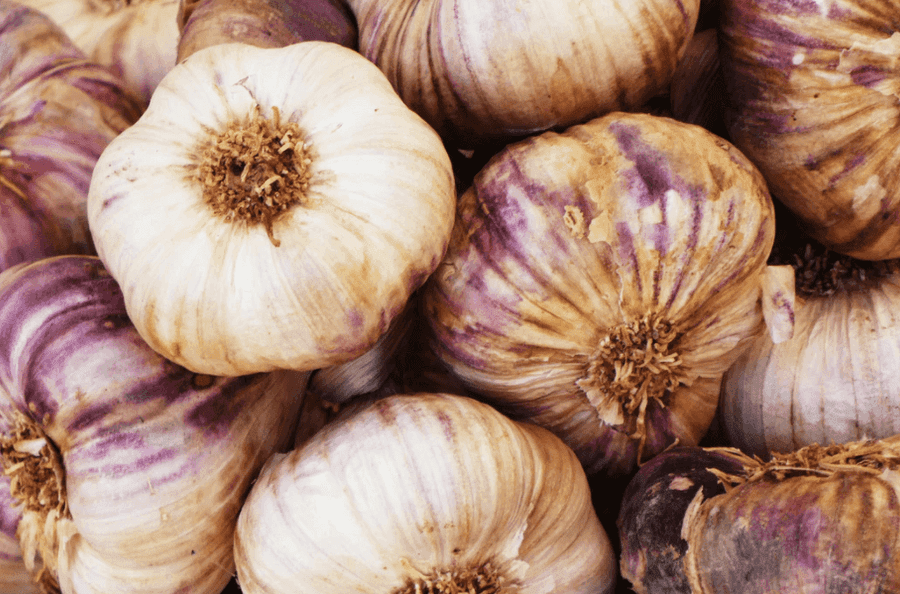The Health Benefits of Garlic
by Amylee Amos PhD, RDN, IFMCPNutrition
Garlic, or Allium sativum, is a culinary herb and vegetable used all over the world to flavor food and provide health benefits. The bulbs, in most varieties split into individual cloves, are the most commonly consumed parts of the plant, though the stems are also edible and used in cooking. While very many cultures include garlic as a common culinary component, Mediterranean, middle eastern, and southeast Asian cuisine are well known for their extensive uses of garlic in cooking.
The benefits of garlic are vast and it has been used as a natural medicinal for centuries. Today, people seek to reap the benefits of garlic through garlic’s use as a culinary ingredient and through supplementation. Garlic is used medicinally in supplement form for a number of conditions including hypertension, hyperlipidemia, atherosclerosis, gastric cancer, and prevention of the common cold (1). Fresh, dried, and extract forms of garlic have been used for their medicinal properties.
Garlic and Heart Health
In regard to garlic as a treatment for atherosclerosis, research shows that garlic supplementation can decrease the reduction in aortic elasticity associated with age. Additionally, specific formulations, such as a time released garlic supplement of 150mg given twice daily over the course of 24 months was shown to reduce the progression of atherosclerosis, measured by carotid intima-media thickness. Higher doses, such as 1200mg twice daily for 12 months, reduced artery calcification progression by 29% compared with placebo. Some of the research reflects that garlic may be more useful in treating arterial stiffness and atherosclerosis in women than in men (2). On a related note, the research indicates that garlic supplementation can increase HDL levels and decrease LDL levels (3). This alteration in lipid levels could serve as an alternative mechanism for the treatment of atherosclerosis.
Garlic and Metabolic Health
To optimize metabolic health, garlic can be used to help with symptoms of diabetes, hypertension, and more. Garlic appears to have a glucose lowering effect in patients being treated for elevated blood glucose with metformin. Garlic also has a potent hypotensive effect, meaning it lowers blood pressure. Meta-analyses of garlic suggest that taking garlic reduces both systolic and diastolic blood pressure levels. In epidemiologic studies, research shows that eating raw garlic twice daily lowers the likelihood of having prehypertension (2).
Garlic as an Antimicrobial
Garlic can help the body fight infection and pathogenic bacteria because it is a potent antimicrobial. Specifically, garlic contains a compound called allicin which exhibits antibacterial activity against a number of classes of bacteria including some antibiotic resistant bacteria. Garlic also has antifungal and antiviral properties (4). For this reason, garlic is often used alongside other botanicals in treatments for gut infections and dysbiosis.
How to Take Garlic
The best way to reap the benefits of garlic is to use garlic regularly in your cooking. Though most of the studies of garlic use standardized garlic supplements (many standardized to contain 1.3% allicin), consuming garlic through food is not only a safer option, but it has also been the administration route of choice for centuries.
When preparing garlic for your meal, chop the garlic cloves, then allow them to sit for about 10 minutes prior to cooking. The enzyme allinase is responsible for the conversion of allinin to allicin, which has shown to have the anti-inflammatory and antioxidant benefits of garlic. Crushing or chopping garlic releases allinase, but allinase is easily broken down by heat. By allowing the garlic to sit after chopping, you allow the allinase to work, thus creating the allicin before cooking.
If you’re looking for some inspiration to help you eat more garlic, try our Basil Pesto, Peperonata, and Parsley Omelets.
Note that if you do choose to supplement with garlic, it is important to discuss you current medications and supplements with your dietitian first because garlic supplements are contraindicated in several disease states and with several classes of medications and herbal supplements (2). If you would like additional assistance creating a nutrition plan that will help you fight disease and achieve your best health, sign up for our Cognitive Health Program today.
References:
- Cooperman, T. (2020). Garlic Supplements Review. Retrieved from:https://www-consumerlab-com.tcsedsystem.idm.oclc.org/reviews/garlic-supplements/garlic/
- Natural Medicines Garlic (2020). Retrieved from:https://naturalmedicines.therapeuticresearch.com/databases/food,-herbs-supplements/professional.aspx?productid=300
- Patel, K. (2020). Garlic. Retrieved fromhttps://examine.com/supplements/garlic/4. Ankri, S., & Mirelman, D. (1999). Antimicrobial properties of allicin from garlic.Microbes and infection,1(2), 125–129. https://doi.org/10.1016/s1286-4579(99)80003-3